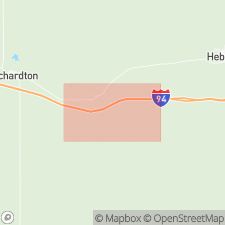
- Usage in publication:
-
- Chalky Buttes Member
- Modifications:
-
- Named
- Dominant lithology:
-
- Mudstone
- Conglomerate
- Claystone
- AAPG geologic province:
-
- Williston basin
Summary:
Named as lower member of late Eocene Chadron Formation (revised) of the White River Group (revised). To avoid confusion, names proposed informally by Stone (1973) for his upper two members of the Chadron are retained here and his informal Amidon member becomes part of the basal Chalky Buttes. Named for the geographic feature of Chalky Buttes. Excellent exposures. Type section is east-facing slope of a north-trending ridge in NW1/4NE1/4NE1/4 sec 25, T134N, R101W in the Chalky Buttes, 6.25 air mi southeast of town of Amidon, Slope Co, southwestern ND. At type, consists of 15 ft of white to purple mudstone overlain by 73 ft of white to yellow-green conglomerate and sandy mudstone. Elsewhere, unit easily recognized, even in scattered and poor outcrops, at many buttes throughout western ND. Rock formerly assigned to the Amidon include <15-ft-thick white claystone or mudstone occasionally seen in areas of Chalky Buttes and Little Badlands. Some outcrops show a feature (unique to this unit) of large scale cross-bedding visible by pink-to-brown pebbles of volcanic porphyries aligned along slip facies. Lithologically similar to Chadron A bed of Schultz and Stout (1955) in Big Badlands of SD, and "dazzling white" unit of Lillegraven (1970) at Slim Buttes, SD. Type section total thickness is 88 ft. Averages 20 ft thick in Little Badlands, 3 to 10 ft thick at Rainy Buttes, >20 ft thick at Black Butte, >30 ft thick at Whetstone Buttes, and 5 to 55 ft thick at small buttes in eastern Stark and eastern Hettinger Cos. Unconformably overlies analcime bed of Paleocene Sentinel Butte Formation (revised) or Paleocene and Eocene Fort Union Group (revised) represented by Bullion Creek or Golden Valley Formations. Conformably underlies Eocene South Heart Member (new). Age is late Eocene based on fossil (brontothere) remains. Report includes geologic maps, measured sections, cross sections, and correlation charts.
Source: GNU records (USGS DDS-6; Denver GNULEX).
For more information, please contact Nancy Stamm, Geologic Names Committee Secretary.
Asterisk (*) indicates published by U.S. Geological Survey authors.
"No current usage" (†) implies that a name has been abandoned or has fallen into disuse. Former usage and, if known, replacement name given in parentheses ( ).
Slash (/) indicates name conflicts with nomenclatural guidelines (CSN, 1933; ACSN, 1961, 1970; NACSN, 1983, 2005, 2021). May be explained within brackets ([ ]).

